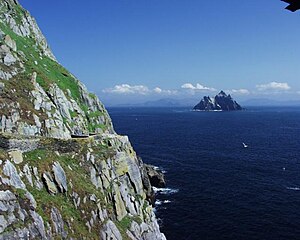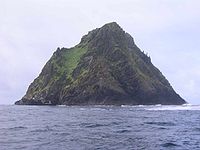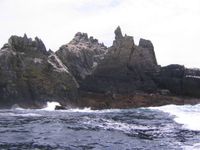Skellig Islands: Difference between revisions
mNo edit summary |
|||
| (One intermediate revision by the same user not shown) | |||
| Line 1: | Line 1: | ||
{{county|Kerry}} | |||
[[File:Littleskelligfromgreat.jpg|right|thumb|300px|Little Skellig seen from Skellig Michael]] | [[File:Littleskelligfromgreat.jpg|right|thumb|300px|Little Skellig seen from Skellig Michael]] | ||
The '''Skellig Islands''' ({{lang|ga|Na Scealaga}}), once known as the Skellocks, are two small, steep, and rocky, uninhabited islands lying about 8 miles west of Bolus Head on the [[Iveragh Peninsula]] in [[County Kerry]]. They are famous for their thriving gannet and puffin populations, and although they appear uninhabitable, Skellig Michael is world-renowned as the site of an early Christian monastery, which is now a UNESCO World Heritage Site. | The '''Skellig Islands''' ({{lang|ga|Na Scealaga}}), once known as the Skellocks, are two small, steep, and rocky, uninhabited islands lying about 8 miles west of Bolus Head on the [[Iveragh Peninsula]] in [[County Kerry]]. They are famous for their thriving gannet and puffin populations, and although they appear uninhabitable, Skellig Michael is world-renowned as the site of an early Christian monastery, which is now a UNESCO World Heritage Site. | ||
| Line 12: | Line 13: | ||
[[File:Little Skellig.jpg|left|thumb|200px|Little Skellig]] | [[File:Little Skellig.jpg|left|thumb|200px|Little Skellig]] | ||
{{Main|Little Skellig}} | {{Main|Little Skellig}} | ||
[[Little Skellig]], the smaller island is closed to the public, and holds Ireland's largest and the world's second-largest [[Northern Gannet]] colony, with almost 30,000 pairs. It is about | [[Little Skellig]], the smaller island is closed to the public, and holds Ireland's largest and the world's second-largest [[Northern Gannet]] colony, with almost 30,000 pairs. It is about a mile east-north-east of Great Skellig. | ||
==Wildlife== | ==Wildlife== | ||
| Line 45: | Line 46: | ||
==Outside links== | ==Outside links== | ||
{{commons}} | {{commons}} | ||
*Location map: {{wmap|51.767|-10.533|zoom=13}} | |||
*[http://whc.unesco.org/en/list/757 UNESCO World Heritage Centre - Skellig Michael] | *[http://whc.unesco.org/en/list/757 UNESCO World Heritage Centre - Skellig Michael] | ||
*[http://www.sceiligs.info A Project Web Site about The Skellig Islands] | *[http://www.sceiligs.info A Project Web Site about The Skellig Islands] | ||
| Line 50: | Line 52: | ||
==References== | ==References== | ||
{{reflist}} | {{reflist}} | ||
{{Catself}} | {{Catself}} | ||
[[Category:Islands of County Kerry]] | [[Category:Islands of County Kerry]] | ||
Latest revision as of 15:07, 10 June 2017

The Skellig Islands (Irish: Na Scealaga), once known as the Skellocks, are two small, steep, and rocky, uninhabited islands lying about 8 miles west of Bolus Head on the Iveragh Peninsula in County Kerry. They are famous for their thriving gannet and puffin populations, and although they appear uninhabitable, Skellig Michael is world-renowned as the site of an early Christian monastery, which is now a UNESCO World Heritage Site.
Skellig Michael
- Main article: Skellig Michael

Skellig Michael, also known as Great Skellig, is the larger of the two islands. It rises sheer from the sea and has two peaks, rising to over 755 feet above sea level.
Close to the south summit is a sixth-century Christian monastery, perched at 525 feet above sea level on a ledge close to the top of the peak. Great Skellig is designated as a UNESCO World Heritage Site.
Little Skellig

- Main article: Little Skellig
Little Skellig, the smaller island is closed to the public, and holds Ireland's largest and the world's second-largest Northern Gannet colony, with almost 30,000 pairs. It is about a mile east-north-east of Great Skellig.
Wildlife
Both of the Skellig islands are well known for their seabird colonies, and together comprise one of the most important seabird sites in Ireland, both for the population size and for the species diversity.
Among the breeding birds are European Storm-Petrels, Northern Gannets, Fulmars, Manx Shearwaters, Black-legged Kittiwakes, Common Guillemots, Razorbills and Atlantic Puffins (with 4,000 or more puffins on Great Skellig alone). Smaller numbers of Choughs and Peregrine Falcons can also be seen.
The surrounding waters teem with life also. Grey Seals are common, and Basking Sharks, Minke Whales, Dolphins, Beaked Whale, and Leatherback Turtles have also been recorded. The islands have many interesting recreational diving sites due to the clear water, an abundance of life, and underwater cliffs down to 200 feet.
Pictures
-
Little Skellig seen from a monk's hut on Skellig Michael
-
SE landing on Great Skellig
-
Skellig Michael
-
Little Skellig
-
Little Skellig seen from Skellig Michael
Popular culture
The Skellig islands are featured prominently in a sequence at the end of the 1976 German film Herz aus Glas (Heart of Glass) by Werner Herzog.
Irish Group Clannad wrote a song "Skellig" for their 1987 Album Sirius.
Canadian singer/songwriter Loreena McKennitt wrote the song "Skellig" for her 1997 album The Book of Secrets.
The 1998 children's book Skellig by David Almond
Tristan Jones, in his sailing/travel novel "ICE!" writes of a visit to the Skellig Isles en route from England to North America in 1961.[1]
In late July 2014, scenes for Star Wars Episode VII were shot on Skellig Michael.
Outside links
| ("Wikimedia Commons" has material about Skellig Islands) |
- Location map: 51°46’1"N, 10°31’59"W
- UNESCO World Heritage Centre - Skellig Michael
- A Project Web Site about The Skellig Islands
References
- ↑ "ICE!" by Tristan Jones ISBN 0-7592-0772-0





